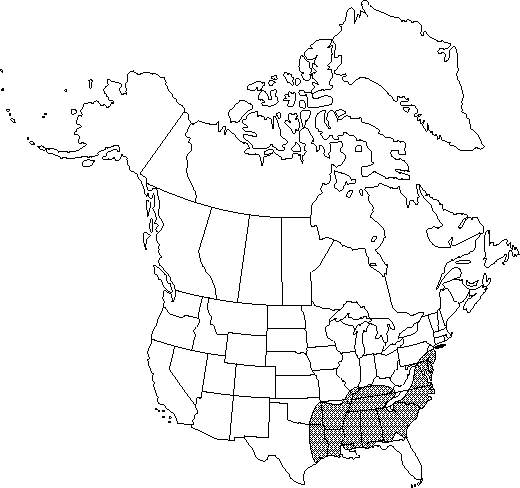Quercus phellos
Sp. Pl. 2: 994. 1753.
Trees, deciduous, to 30 m. Bark dark gray and smooth, becoming darker and irregularly fissured with age, inner bark light orange. Twigs reddish-brown, 1-2 mm diam., glabrous. Terminal buds chestnut-brown, ovoid, 2-4 mm, apex acute, glabrous. Leaves: petiole 2-4 (-6) mm, glabrous, rarely sparsely hairy. Leaf-blade linear to narrowly elliptic, usually widest near middle, 50-120 × 10-25 mm, base acute, margins entire with 1 apical awn, apex acute; surfaces abaxially pale green, glabrous, rarely softly pubescent, adaxially light green, glabrous. Acorns biennial; cup shallowly saucer-shaped, 3-6.5 mm high × 7.5-11 mm wide, covering 1/4-1/3 nut, outer surface puberulent, inner surface light-brown, pubescent, scale tips tightly appressed, acute; nut ovoid to hemispheric, 8-12 × 6.5-10 mm, often striate, glabrate, scar diam. 4.5-6 mm.
Phenology: Flowering spring.
Habitat: Of bottomland flood plains, also on stream banks, dunes, and terraces, and, occasionally, on poorly drained uplands
Elevation: 0-400 m
Distribution

Ala., Ark., Del., D.C., Fla., Ga., Ill., Ky., La., Md., Miss., Mo., N.J., N.Y., N.C., Okla., Pa., S.C., Tenn., Tex., Va.
Discussion
Individual trees with leaves softly pubescent abaxially may be classified as Quercus phellos forma intonsa Fernald; however, such leaves are known to occur on second-flush shoots from twigs bearing typical leaves.
Quercus phellos reportedly hybridizes with Q. coccinea (W. W. Ashe 1894); with Q. ilicifolia (= Q. ×giffordi Trelease) and Q. incana (E. J. Palmer 1948); and with Q. marilandica, Q. nigra, Q. pagoda (= Q. ×ludoviciana Sargent), Q. palustris, Q. rubra, Q. shumardii, and Q. velutina. D. M. Hunt (1989) cited evidence of hybridization also with Q. hemisphaerica, Q. imbricaria, Q. laurifolia, and Q. pumila.
Selected References
None.
